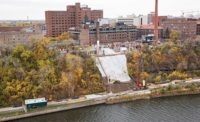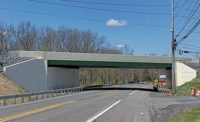ENR MidAtlantic 2019 Best Projects
Best Small Project: Route 30 Landslide Remediation

Crews worked 24/7 to rebuild a hillside section of Route 30, an 80-year-old highway that carries about 30,000 travelers a day.
Photo by Brian Heinzl, courtesy Gannett Fleming

To stabilize the hillside, the team made it a priority to maximize the retaining wall’s functionality and durability.
Photo by Identified Technologies Corp., courtesy Gannett Fleming

While excavators were finishing removing debris, the team says it began geotechnical investigations and analysis, and likewise began wall design before the investigations were complete.
Photo by Dan Hunter, courtesy Gannett Fleming



Route 30 Landslide Remediation
East Pittsburgh, Pa.
BEST PROJECT
Owner: Pennsylvania Dept. of Transportation, Engineering District 11-0
Lead Design Firm: Gannett Fleming
General Contractor: Golden Triangle Construction
Geotechnical Drilling & Core Sampling: Armstrong Drilling
Emergency Excavation: Allison Park Contractors
Design & Right-of-Way Planning: Monaloh Basin Engineers
During an investigation of potential buckling on a heavily traveled hillside highway, the team advised police to evacuate a community hours before a landslide sent 300 ft of roadway and thousands of tons of soil plummeting down 90 ft.
The team’s quick response resulted in 31 people being evacuated from affected apartments and homes. The effort is estimated to have saved the lives of a dozen area residents whose dwellings were damaged by the landslide. The remaining residents were evacuated when they lost their utilities.
For this $6.9-million design-build project, which was completed on budget and three days ahead of schedule, the team took an unconventional approach to designing a 400-ft-long retaining wall and a 90-ft embankment while removing 35,000 cu yd of debris.
Crews worked 24/7 to rebuild a hillside section of Route 30, an 80-year-old highway that carries about 30,000 travelers a day. The design and bid package was delivered in what team members say was an unprecedented 10 days. Even under emergency conditions, the industry typically requires 10 weeks or more, the team says.
“They were collecting data while they were still cleaning up from the landslide,” one judge says. “So many aspects of this were outside the realm of how a project would typically move so that they could get this roadway functional for the folks who depended on it.”
Following the landslide, the team conducted a site assessment for continued slope movement before the rebuilding began. While excavators were finishing removing debris, the team says it began geotechnical investigations and analysis, and likewise began wall design before the investigations were complete.
Information on the 80-year-old roadway’s construction was “almost nonexistent,” so, the team says, it “had to be creative to obtain the data it needed to determine proper wall beam depth and layout.”
The team says it also conducted “geotechnical detective work” that allowed design to begin within hours of the collapse. Using Lidar imaging for mapping and surface contours of the site, the team cut cross sections through the landscape to identify the ground surface before the landslide.
To stabilize the hillside, the team made it a priority to maximize the retaining wall’s functionality and durability. The team worked with nearby mills to procure steel for the anchored soldier pile lagging retaining wall with 51 steel piles, 42 drilled shafts and 100-kip anchors for long-term stability.
“When data from the final boring showed an unexpected absence of the targeted foundation sandstone, designers reacted quickly to keep the project on schedule,” the team says. “They redesigned a 75-ft section of the wall, lengthening support beams by 10 ft and specifying the replacement of existing landslide-prone soils with granular material that would lighten the lateral forces on this section of wall, ensuring its stability.”
One judge says, “I’ve always been impressed at how powerful the common goal can be to a project team; it’s clear to me that occurred on this project with the goal of getting the roadway restored for passengers and the people that use it.”
Back to "MidAtlantic's 2019 Best Projects Shine Across The Region"






